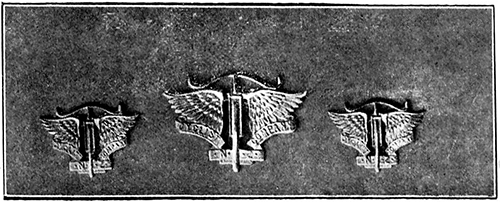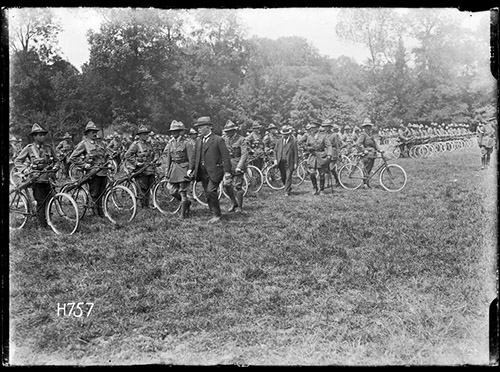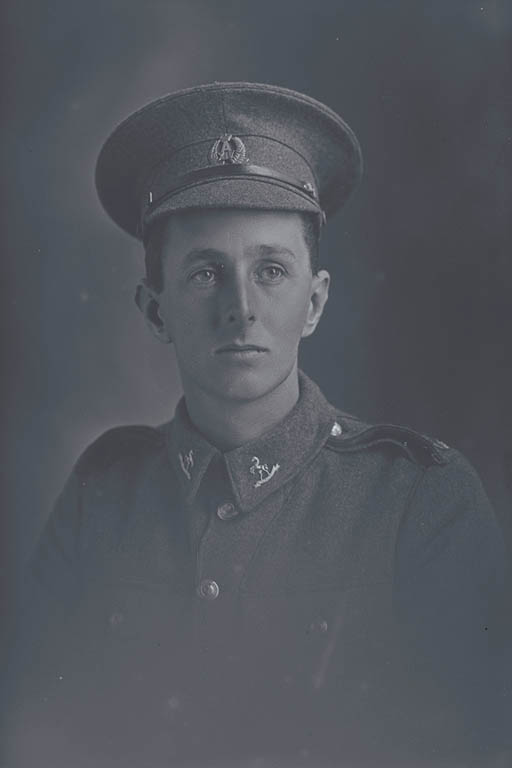Charles Southey
Charles Carrington Southey was a member of the 1st New Zealand Cyclist Company during the First World War. A cycling craze had swept the Western world in the late nineteenth century, and the bicycle was swiftly co-opted for military use. Bikes were found to be invaluable for reconnaissance and communication work during the Second Boer War, and by the start of the twentieth century there were approximately 8,000 cyclists across the various Companies and Volunteer sections of the British Army.1
New Zealand
Southey was the great-grandson of Robert Southey, an English poet of the Romantic school and Poet Laureate from 1813–1843.2 Robert Southey’s grandson Herbert Southey emigrated from England to Hawera in the late nineteenth century, and married Fanny Hawkins there in 1888. Charles Southey was born the year after, and the family moved to Tauranga in 1898.3
While at the Teachers’ College in Auckland from 1909–1910, Southey also attended classes at Auckland University College in 1910 as a non-matriculated student.4 After he qualified, he returned to the Bay of Plenty as headmaster of Paengaroa School.5 In 1913, the School Committee presented him with a ‘handsome combined dressing case and travelling bag, suitably inscribed’, in appreciation of his leadership of the school.6
 '1st Cyclist Company badge. Issued in New Zealand.'Regimental history of New Zealand Cyclist Corps in the Great War 1914-1918, Auckland, 1922, pp.14-15 NZGC 940.41295 R33, Special Collections, University of Auckland Libraries and Learning Services.
'1st Cyclist Company badge. Issued in New Zealand.'Regimental history of New Zealand Cyclist Corps in the Great War 1914-1918, Auckland, 1922, pp.14-15 NZGC 940.41295 R33, Special Collections, University of Auckland Libraries and Learning Services.
War service
Southey enlisted on 4 March 1916, and expressed a preference for the Mounted Rifles.7 However, while he was training with the Mounted Rifles at Featherston Camp, the unit was asked to provide men for a new cyclist company which the New Zealand government had agreed to as part of the 12th Reinforcements; Southey volunteered. A badge consisting of a winged cycle front wheel and handlebars, with a scroll beneath bearing the name of the unit was approved, and the 1st New Zealand Cyclist Company was formed.8
The 12th Reinforcements left New Zealand in May 1916, and landed at Tel-el-Kebir Camp in Egypt.9 Many of the men on board had never been on the ocean before, which ‘accounted for that squirmy feeling in the region of the waistcoat’.10 As they reached the entrance to the Red Sea, the heat was ‘terrific’ and ‘most men discarded their clothes to the utmost limits of decency (two nurses on ship)’.11
The Company was in Egypt for a fortnight, drilling in the early mornings and late at night to avoid the heat, before being amalgamated with an Australian unit to become the 2nd Anzac Cyclist Battalion and sent to France.12 They went to Egypt without bicycles, which arrived in France in early August 1916.13
The official duties of the cyclists included traffic control, felling trees, burying cables, reconnaissance, and taking part in offensives as advanced mounted troops.14 During the years 1917–1918, the Battalion excavated over 56 miles of trenches in France to accommodate about 5,600 miles of wire.15 They also served as infantry in the front lines — after appropriately storing their bicycles, which were useless in trench warfare.16
While the muddy morass of the front lines precluded the use of bikes, they were still very useful for moving the Battalion around France, even though the French roads were often difficult in the winter. Some of the climbs undertaken were long and steep, and ‘endurance was severely taxed in negotiating some of the rises, particularly on a frozen road which was as slippery as glass. Spills were frequent and our temper sullen.’17
Southey received the Military Medal for ‘bravery in the field’ at Passchendaele in October 1917.18 On 1 November 1918, finding his reconnaissance duties south of Valenciennes ‘impracticable owing to the proximity of the enemy’, Southey joined in with the infantry, ‘who were few and hard pressed’. During their subsequent retreat, Southey successfully repelled a counter attack, and was awarded the Military Cross for his part in the action and the clear report he submitted later that day.19
After the Armistice was signed in November 1918, what was now the New Zealand Cyclist Battalion was ordered to Baudour, Belgium as part of the occupying force. Military training was largely replaced by rugby, and Southey helped to provide education for the men.20
The Battalion had impressed the French General A. Berthelot when it fought alongside the French Army during the Second Battle of the Marne in France in July and August 1918. In July 1919, Southey was part of the group that travelled to Épernay to receive a fanion [small flag] from General Berthelot in recognition of their part in turning back a German attack close to the champagne-producing town during that battle.21
 Inspection of the New Zealand Cyclist Battalion by William Massey and Joseph Ward, 3 July 1918 in France. Royal New Zealand Returned and Services' Association: New Zealand official negatives, World War 1914-1918. Ref: 1/2-013358-G. Alexander Turnbull Library, Wellington, New Zealand.
Inspection of the New Zealand Cyclist Battalion by William Massey and Joseph Ward, 3 July 1918 in France. Royal New Zealand Returned and Services' Association: New Zealand official negatives, World War 1914-1918. Ref: 1/2-013358-G. Alexander Turnbull Library, Wellington, New Zealand.
After the War
Southey left for New Zealand in August 1919, and returned to his position as headmaster of Paengaroa School.22 He moved to become headmaster of Whakatane School in the early 1930s.23 He married Betty Harding and the couple had four children.24 He became headmaster of Tauranga District High School in 1942 and during the Second World War was seconded as temporary Captain of the Tauranga District High School Cadets until he was posted to the retired list in 1946.25
Charles Southey died in Tauranga in June 1976.
Jonathan Burgess, Special Collections
- Hilary Searle, ‘The Army Cyclist Corps’, CycleSeven, accessed 24 July 2014; D.R. Maree, ‘Bicycles in the Anglo-Boer War of 1889–1902’, Military History Journal, 4, 1, 1977.
- New Zealand Herald, 10 July 1930, p.16; Geoffrey Carnall, ‘Southey, Robert’, Oxford Dictionary of National Biography, accessed 22 July 2014.
- New Zealand Herald, 14 July 1923, p.10; 10 July 1930, p.16; 11 February 1937, p.12; ‘Charles Carrington Southey’, Cenotaph Database, Auckland War Memorial Museum, accessed 22 July 2014.
- ‘Southey, Charles Carrington’, A.U.C. Roll of Honour. MSS & Archives E-2, Special Collections, University of Auckland Libraries and Learning Services.
- Bay of Plenty Times, 14 February 1913, p.4.
- ibid.
- ‘Southey, Charles Carrington – WW1 10918 – Army’, R7819976, Archives New Zealand, Wellington.
- Regimental History of New Zealand Cyclist Corps: The Great War 1914–1918, Auckland, 1922, pp.14–15. NZGC 940.41295 R33, Special Collections, University of Auckland Libraries and Learning Services.
- ibid., pp.17–19; ‘Southey, Charles Carrington – WW1 10918 – Army’.
- Regimental History of New Zealand Cyclist Corps, p.17.
- ibid., p.18.
- ibid., pp.19–22.
- ibid., p.24.
- ibid., foreword.
- ibid., p.38.
- ibid., pp.28, 71.
- ibid., p.34.
- London Gazette, 28 January 1918, p.1406.
- ibid., 10 December 1919, p.15399; Regimental History of New Zealand Cyclist Corps, p.94.
- ibid., p.106.
- ibid., p.113.
- ‘Southey, Charles Carrington – WW1 10918 – Army’; Te Puke Times, 9 July 1920, p.2.
- New Zealand Herald, 1 February 1933, p.12; Bay of Plenty Beacon, 9 February 1942, p.4.
- ‘Southey, Charles Carrington – WW1 10918 – Army’; Personal correspondence.
- ibid.; Bay of Plenty Beacon, 9 February 1942, p.4.



